| |||||||
| Search Forums |
| Advanced Search |
| Go to Page... |
 |
| Search this Thread |  691,924 views |
| | #1 |
| Distinguished - BHPian  Join Date: Aug 2014 Location: Delhi-NCR
Posts: 4,071
Thanked: 64,305 Times
| Scale Models - Aircraft, Battle Tanks & Ships This thread is dedicated to scale models of aircrafts and ships, both civil and military. The models could be die cast, plastic-resin, wood or whatever else so long as they are scale models. As far as possible please add a few lines on the aircraft. In case it is a specific tail number with a history you know of then sharing that will liven this thread. Speaking for myself I acquire these models at a slow steady pace going for aircraft and tail numbers that had a meaningful historic significance. Some models were bought off the shelf at shops while others were custom built. The one's I get custom made are always either linked to Indian aviation, the IAF or my own business. Air India's L-749 Malabar Princess My favourite model is the Lockheed Constellation L-749 of Air India International named Malabar Princess. The first international flight by an Indian carrier was undertaken by this aircraft, Bombay-London in 1948 with Capt. KR Gazder in command. Sadly this aircraft was lost, in 1950, in a crash in the Alps near Mt. Blanc.  Note the constantly varying diameter of the fuselage. This was so to reduce drag. While it gave the 'Connie' a gracious look it made internal cabin arrangements less optimal. One learning from this is the straight tube fuselages we see in all airliners today. The 22 feet high triple tail was so designed for both stability, greater control and to keep the tail height low enough to enter hangars then in use. The 123 feet wing span carried about 20,000 litres of fuel. Don't miss the tri-colour on the centre tail fin. 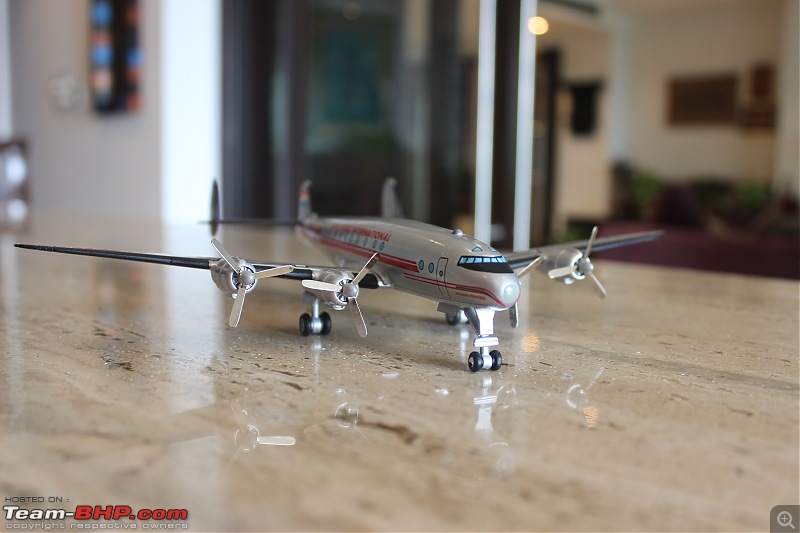 Note the 4 Wright turbo-compound piston radial engines each of which delivered 2500 hp and drove the 15 foot diameter props. The Constellation had a large flight deck crew - Capt, co-pilot, flight engineer, navigator and radio operator. When flying over the north pole two navigators was the norm.  Attention to detail right down to the name. This is a 1:144 die-cast scale model by Corgi brought out in 1998 on the 50th anniversary of the first flight. Wing Span is about 10" and length a little over 8". 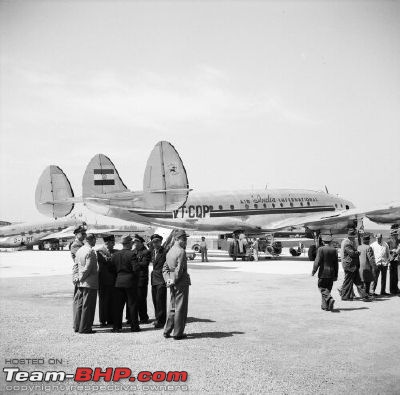 The Malabar Princes in real life The Constellation L-749 cruised at ~500 kmph carrying 40 to 60 passengers (81 in all economy). The Air India planes were configured for 42 with reclining sleepers for all. The aircraft flew about 4000 kms at full payload. Introduced in the mid-1940s soon after WW2 the Constellation was the first commercial airliner to be pressurized to fly above the weather, to be properly air conditioned and to be fitted with sound insulation that actually worked. At just under 100 feet in length and a wing span of 120 feet it was a big big aircraft for its time. The L-749 and its follow on the Super Constellation were synonymous with international flying till 1958. Messerschmitt Me 262 The Me 262 was the world's first jet fighter to enter series production and the first to see combat in World War 2. A marvel of engineering for the 1940s. It out flew and out climbed anything the Allies had. In one incident in 1944 six Me 262s shot down 15 American 4-engined bombers in 15 minutes for no loss to themselves.  It was powered by two Junkers Jumo turbojets providing a total of 1800 kgf of thrust and a top speed of 900 kmph. This made it about 180 to 200 kmph faster than the fastest allied piston engined fighters of the era. Armed with four 30mm cannons it downed 542 Allied aircraft in the last 10 months of the war. The model shows the streamlined airframe, the two jets slung under the wings, the four cannons on the nose and the high tail (to avoid being affected by the jet's efflux).  This is a 1:48 die cast scale model. 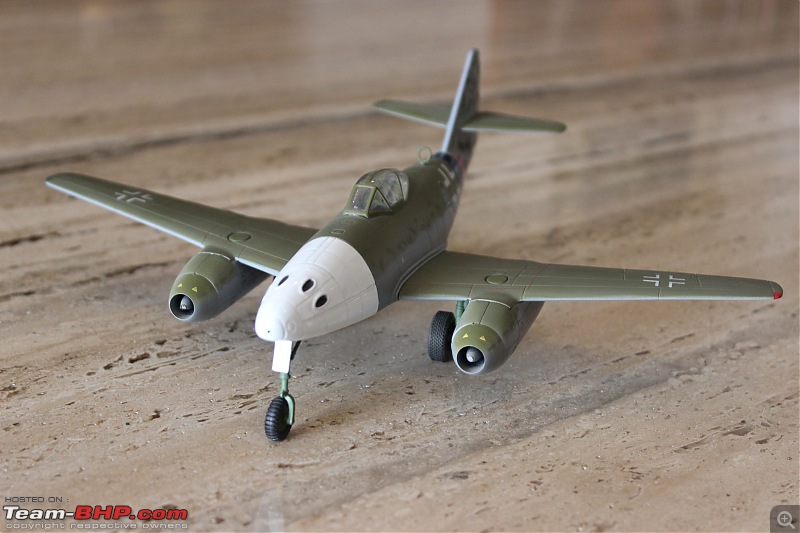 The Germans built about 1430 of these sleek machines despite the shortages of materials in WW2. The Allies, after victory, carted away dozens of Me262s to examine and test and then use as the basis to improve their own more nascent fighter jet designs. Fuel burn at full throttle was about 41 kgs a minute. 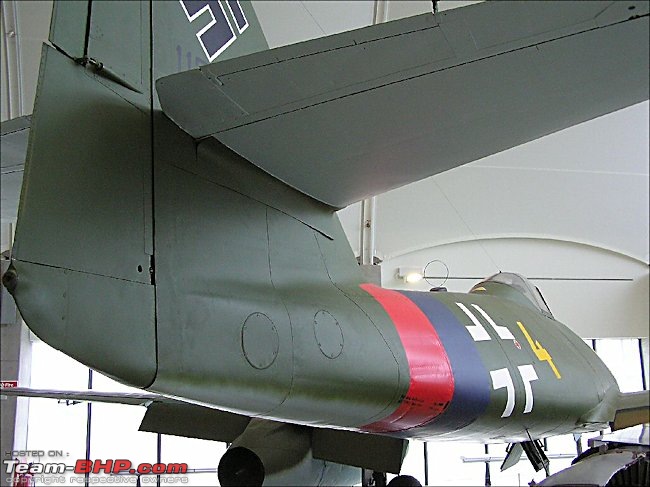 The model is based on a real Me 262 now at the RAF Museum in Hendon, England. Note the colour band on the rear fuselage and the number 4. I do not know the history behind this particular airframe. de Havilland Comet 4 The de Havilland Comet is assured a place in aviation history as the first commercial jet airliner to go into production and regular service in 1952 - 6 years ahead of the vaunted Boeing 707. By flying at ~840 kmph instead of 500-550 kmph it cut journey times and more importantly got rid of the significant noise and vibrations that accompanied piston engine air travel. This beautiful and graceful airliner was a decade ahead of its time and sadly suffered 4 instances of aircraft disintegrating in mid-flight. This led to its grounding. Extensive research discovered problems with metal fatigue and need for superior aluminum alloys. The result was the Comet 4 shown below which entered service in end-1958. Boeing and McDonnell Douglas both gained from the pioneering research done by the British and came out with their Boeing 707 and Douglas DC-8 and captured the jetliner market. The de Havilland Aircraft Company got absorbed into Hawker Siddley in 1960 and disappeared. 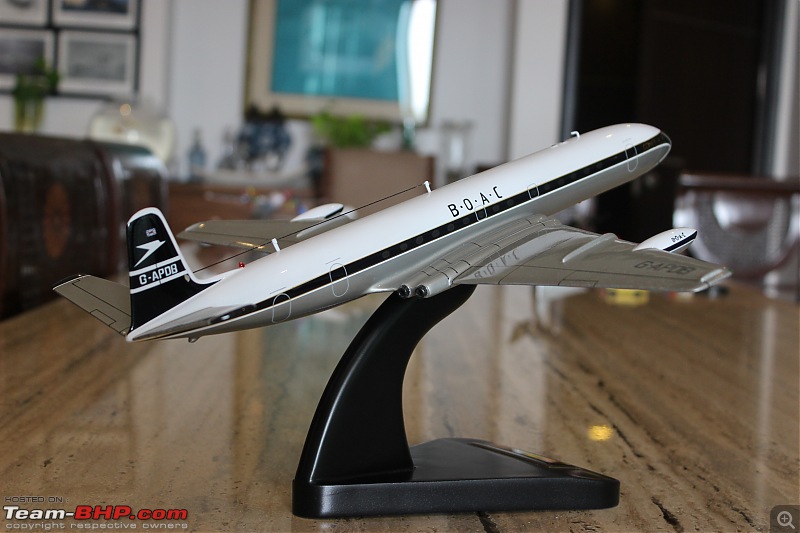 Note the slender streamlined airframe and the gentleness with which the wings blend into the fuselage. This particular aircraft G-APDB made aviation history when it flew the first trans Atlantic passenger service of any jet airliner from New York to London on 4th October 1958. Pan Am caught up, a month later, with the inauguration of their Boeing 707 flight on the same route. Note the radio aerial wire strung over the top of the fuselage.  Photo shows to good effect the 4 Rolls Royce Avon turbojets each belting out around 4750 kgf at full power. The engines were buried in the wing roots to reduce drag. Though this position is not useful for maintenance. Back in the 1946 when design work on the Comet started it was not still clear which was the best configuration to place a jet power plant on a commercial airliner. The current almost usual practice of slinging them below the wing was still a few years away. Interestingly the world's second (and very successful) jet airliner the Tupolev Tu-104 also had engines buried in the wing roots. 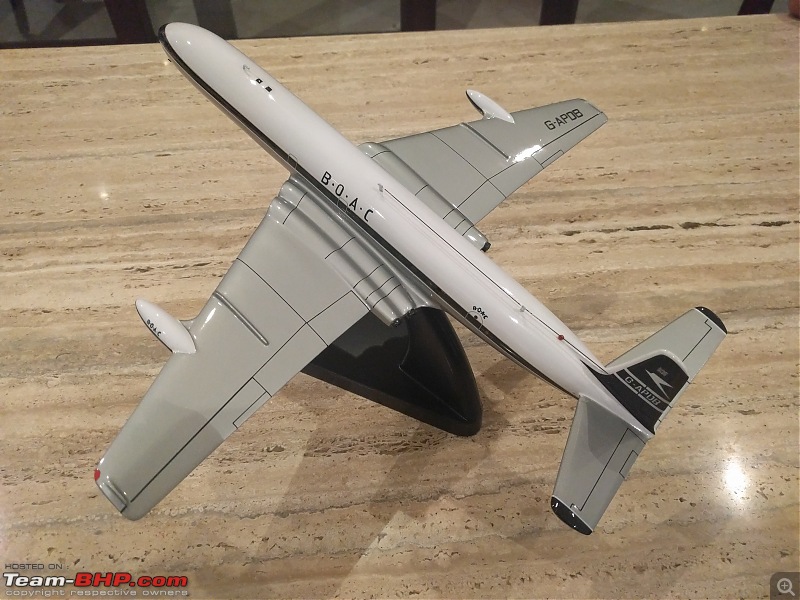 This model is made of plastic-resin and is about 18" long with the wing span spreading to 19". The Comet was the first civilian airliner to sport swept back wings which are compatible with the higher speeds jet propulsion is capable of. The Comet in its prime carried 56 passengers and flew at around 850 kmph much like a modern airliner. The bulbs you see on the wings are long range fuel tanks. 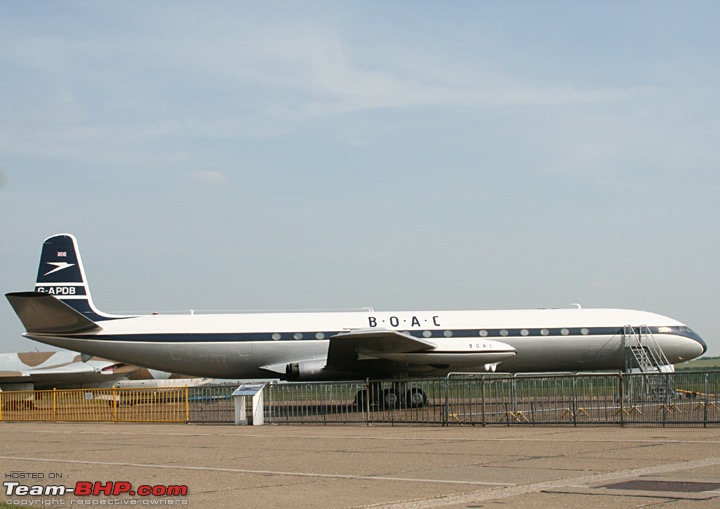 The real G-APDB in flesh. In 1974 it was retired and is now in a museum in the UK. Caravelle VI.N The French Sud Aviation Caravelle was the western world's first 'regional jet'. It was the western world's second jet to enter service (after the Comet). The French were careful to observe and learn the lessons from the de Havilland Comet's tragedy and subsequent findings. While the Americans went for developing the large jets for the international routes the French sensibly aimed for the short to medium range market and captured it. The Caravelle was built in many variants of weight, engine power and fuselage length. The VI.N was one of the most popular versions. A total of 282 were built - a respectable number for the 1950s and 60s. 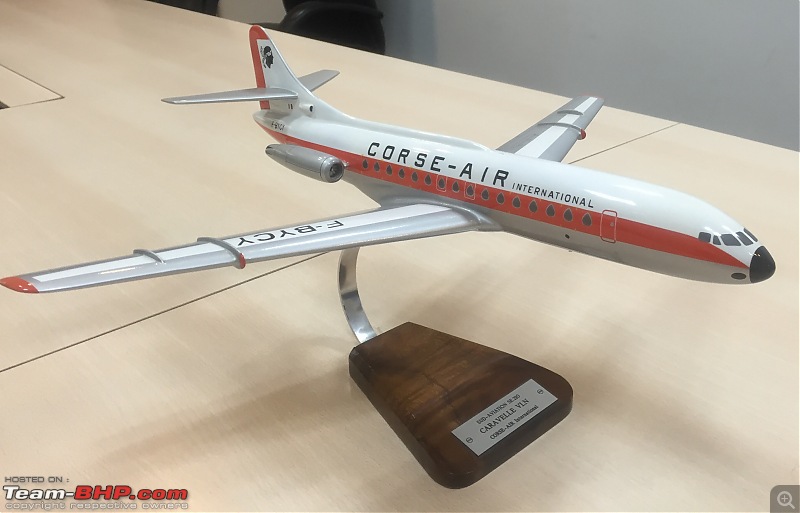 Note the similarity of the nose to that of the Comet above. Sud Aviation licensed the design of the nose and cockpit layout from de Havilland. The Caravelle was as beautiful as the Comet and better proportioned. Sud Aviation chose the then new engine layout of mounting the power plant on the rear fuselage. This successful layout was copied by several other American, Russian, Dutch and British medium airliner jets that came into service in the 1960s and 1970s. One reason for this rear engine layout was to reduce noise in the passenger cabin. Early jets were far more noisy than today's turbofans and cabin noise was an important issue to address. Sud Aviation later morphed along with others into today's Airbus company.  The Caravelle first flew in 1955 and entered service with Air France in 1959. Note the slightly swept wings that gave the aircraft a cruise speed of 780 kmph powered by its two Rolls Royce Avon turbojets delivering a total of ~11,000 kgf of thrust. These were derivatives of the engine that powered the Hawker Hunter fighter of the 1950s and 1960s. To watch a Caravelle take off was a challenge to the ears - the equivalent of two roaring fighter jets taking off together. 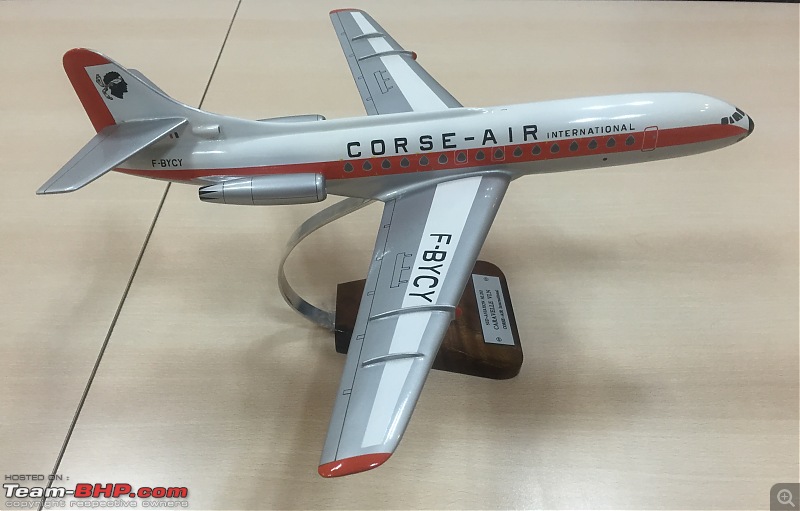 The Caravelle had large tear drop shaped windows which were much larger than the liner ones we are used to today. This design was retained in all versions. The airliner seated between 80 to 100 passengers. Indian Airlines operated seven Caravelles. The seat pitch ie distance between seats was typically 37" which is comfortable when compared to the 30" to 33" used on most single aisle aircraft today. This is a 1:72 scale model made of plastic resin. Note the air intake opening at the base of the vertical tail - that's the intake for the auxiliary power unit. Note also the small vertical fittings on the wings. Those are wing fences to improve the 'grip' of the airflow of the aerofoil. This model is about 19" in length.  The real F-BYCY. It is today preserved in France and operates as a karoke bar! ATR 42 This is an aircraft most Team BHPians would be familiar with - the ATR. It is common in India being operated by Jet Airways, Air India and the erstwhile Kingfisher. It is a commuter turbo prop for short hops. The ATR 42 shown here seats between 40 to 50 passengers. Other than passenger there are other variants -cargo, VIP, geological survey and so on. The ATR 42 entered service in 1985 and along with its longer cousin the ATR 72 about 500 have been produced and production is in full steam 30 years on of a gradually improved product. A successful transport plane.  If you visit ATR's assembly plant in Toulouse (or one of their offices I suppose) they gift you a model of their product. If you are a biiiiiiggg customer you get a 24" scale model. If you are a sidekick you get a 12" one. And if, like me, you are the lowest form of avian life you get a 9" one. This one is 9 inches.  The ATR is powered by two Pratt & Whitney turbo props generating between 2100 to 2700 shp depending on the variant. The props these days are made of composites with complex twists and turns on all three axis. These 6 blade screws are more efficient and quieter than the simpler three blade ones you see on the Constellation above. That's five models for now. More a little later as this thread develops. BHPians are invited to share their scale models of aircraft and ships along with a description/history of the machine. Last edited by V.Narayan : 3rd August 2016 at 22:53. |
| |  (14)
Thanks (14)
Thanks
 |
| The following 14 BHPians Thank V.Narayan for this useful post: | AdityaDeane, Anjadekar, ashivas89, BoltThrower, GTO, ike, Potatopoco, ruzbehxyz, Samba, shancz, SnS_12, SolitaryRabbit, Turbanator, zurura023 |
| |
| | #2 |
| Team-BHP Support  | Thread moved from the Assembly Line to Shifting Gears. Thanks for sharing! Last edited by GTO : 5th August 2016 at 08:51. Reason: Bump |
| |  ()
Thanks ()
Thanks
 |
| | #3 |
| BHPian Join Date: Aug 2015 Location: BLR-UD
Posts: 220
Thanked: 841 Times
| re: Scale Models - Aircraft, Battle Tanks & Ships That's a great collection sir. Waiting for other model pics from your collection. Some time back my BIL got scale model of LCA as a souvenir for successful completion of the project. But it was too plasticy, no aesthetic value in it, no where close to the aircraft's look. Even kids didn't like it. |
| |  ()
Thanks ()
Thanks
 |
| | #4 |
| Senior - BHPian | re: Scale Models - Aircraft, Battle Tanks & Ships Wow, thanks for the amazing and detailed history of some very interesting airplanes. I used to collect a lot of these when I was younger but realised that they just were being stored away and not displayed. Some of my favourites in my collection were F117 Nighthawk, SR71 Blackbird and the A10 Warthog. |
| |  ()
Thanks ()
Thanks
 |
| | #5 |
| BHPian Join Date: Nov 2015 Location: MH01/TS09
Posts: 697
Thanked: 1,760 Times
| re: Scale Models - Aircraft, Battle Tanks & Ships   First: Awesome Pics of your Super Awsome collection! Second: Awesome details about the specifications Third: Where can I buy these beauties? I have a lot of cars in my collections, but never got good planes to collect. I would like to build an entire plane collections for my self (Of Course my kids can play with them after I bequeath them in my will) |
| |  ()
Thanks ()
Thanks
 |
| | #6 | ||
| Distinguished - BHPian  Join Date: Aug 2014 Location: Delhi-NCR
Posts: 4,071
Thanked: 64,305 Times
| re: Scale Models - Aircraft, Battle Tanks & Ships Quote:
Quote:
Thank you for your compliments. I am in my mid-50s. Guess you cannot ever take the boy out of the man! Now to your question - I assume they are available on the net these days though I have never gone down that route yet - Corgi is very good. My sources are - every aircraft museum has a shop; some international airports have shops - Frankfurt & Munich are such; most large towns in the West and Singapore/Hong Kong in the East have shops but one has to hunt them down - over the last 3 deacdes many have closed down. In Delhi there is a shop in Connaught Place and one in Green Park that sell plastic (but fairly good) models. My favourite is a derelict 60 year old shop in Geneva which only specializes in this merchandise. I visit there on business only once a year in May - tell him what I want next year leave an advance and he hunts it down for me to be picked up the following May. If you want to order custom made then try 'Factory Direct Models'. Hope this helps. Next up will be the Bristol Beaufighter a multi-role British attack aircraft from World War II and the Hawker Siddeley Harrier vertical take-off jet. | ||
| |  ()
Thanks ()
Thanks
 |
| | #7 |
| Distinguished - BHPian  Join Date: Aug 2014 Location: Delhi-NCR
Posts: 4,071
Thanked: 64,305 Times
| re: Scale Models - Aircraft, Battle Tanks & Ships The Bristol Britannia This is a long range turbo-prop from Britain that entered service in 1957. For its time it was a very long ranged passenger transport. With a passenger payload of 80 in business class layout it regularly flew the 9100 odd kms between Tel Aviv and New York non-stop. The big four engined jets bettered that only with the introduction, eight to nine years later, of the turbofan engined Boeing 707-320B and McDonnell Douglas DC-8 Series 62.  The Britannia, like the Comet (post #1) was a British innovation marrying a modern airframe to large turboprop power plants i.e. the Bristol Proteus. Each power plant developed 4450 e.h.p. This stands for effective horse power ie the combination of both the propellers thrust and the thrust of the hot unused exhaust going backwards. The propellors have been crafted accurately as has the engine inlet. The plane cruised at 650 kmph to 675 kmph which wasn't too far off from the 750 to 800 kmph of the Caravelle (see post #1) an early jetliner. From amongst non-Soviet aircraft the Britannia was the longest ranged and fastest propeller driven passenger transport. But it came too late. Early jetliners were powered by thirsty noisy turbojets which made long range flying with an economical payload a tough proposition. The turboprops offered a mid-way solution of fuel economy with slightly lower speeds and a lot less noise. 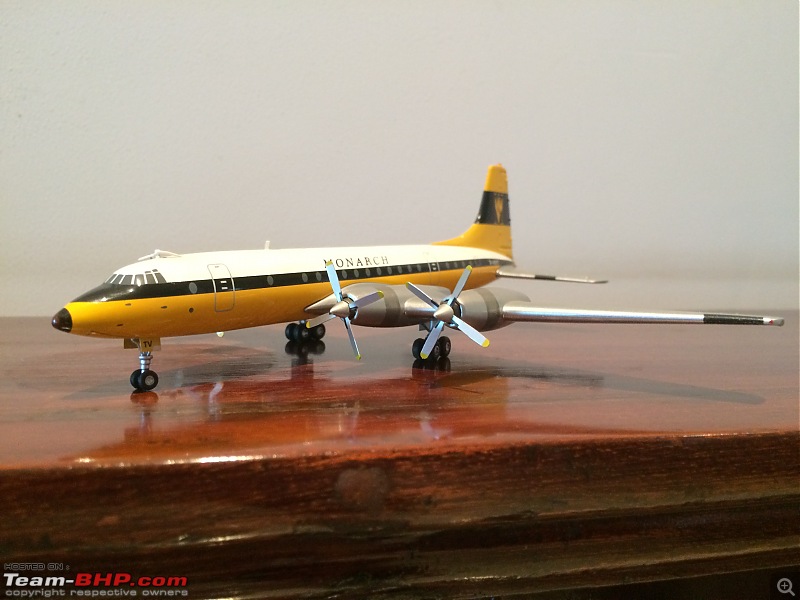 Sadly, though the prototype flew as early as 1952 the problems with the engine were not sorted out till 1957 by which time airlines were no longer interested in a long range turboprop when pure jets were in their final stages of testing and expected to enter service the following year. Only 85 of these path breaking machines were built. The Britannia was one of the rare if not the only major western airliner to be sold to the Communist bloc during the cold war with a few operating with Cubana Airlines of Cuba. Cubana became the last operator of the type retiring them in 1990.  This is a 1:200 scale model. The actual aircraft first flew with B.O.A.C. and later with the British airline Monarch. It was built in December 1958 and completed the last passenger flight ever by a British Britannia in October 1975. She is now preserved at the Duxford Aerodrome museum in the UK.  The real G-AOVT Sepecat Jaguar The Sepecat Jaguar was designed and built by a British-French consortium to be a low level attack aircraft. It was selected by the Indian Air Force (IAF) to be our primary attack aircraft or Deep Penetration Strike Aircraft (DPSA). It was built in India under license from the early 1980s to the early years of the last decade. India even today has around 140 in service and it has probably the best safety and reliability record of any aircraft in the current IAF inventory. 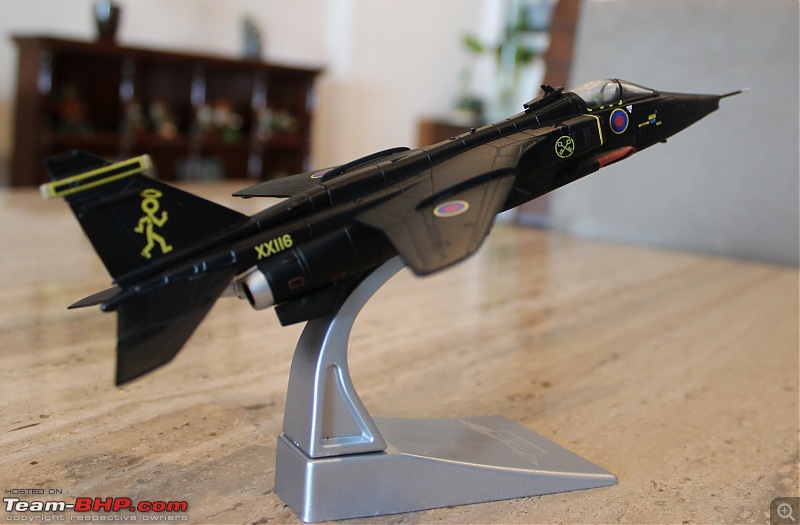 This is a 1:72 scale model of the aircraft in British Royal Air Force service with the famous 16th Squadron whose informal symbol is the walking key seen on the tail. Note the twin Rolls Royce Adour engines, the thin swept back wing for fast flying, the small wing to minimize low level ride discomfort at high speeds.  The chisel shaped nose contains the laser range finder and target seeker, the red piece under the cockpit are the 30mm Aden cannons 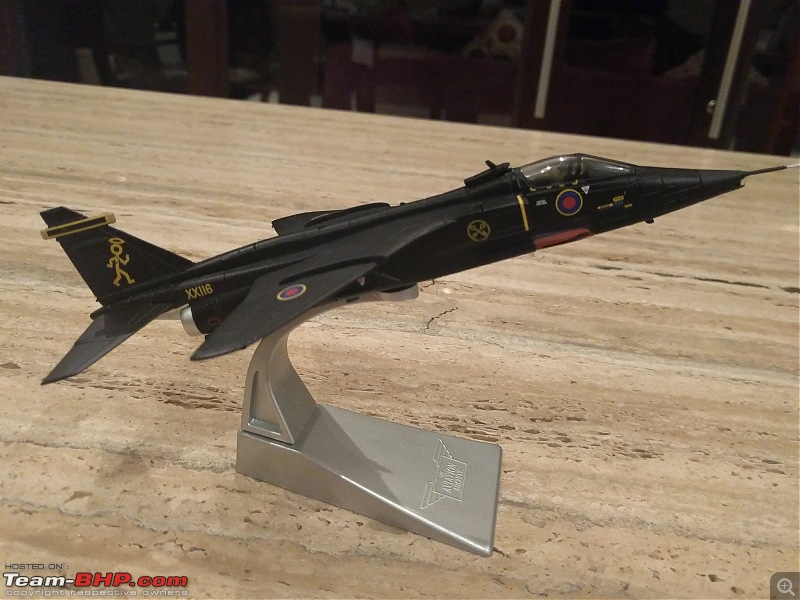 The Jaguar can carry a warload of approximately 4500 kgs; has a combat radius flying lo-lo-lo of between 500 to 800 kms depending on the weapons payload and in 'clean' condition at altitude can reach ~1700 kmph. If flying hi-lo-hi the machine can achieve a combat radius of well beyond 1000kms. 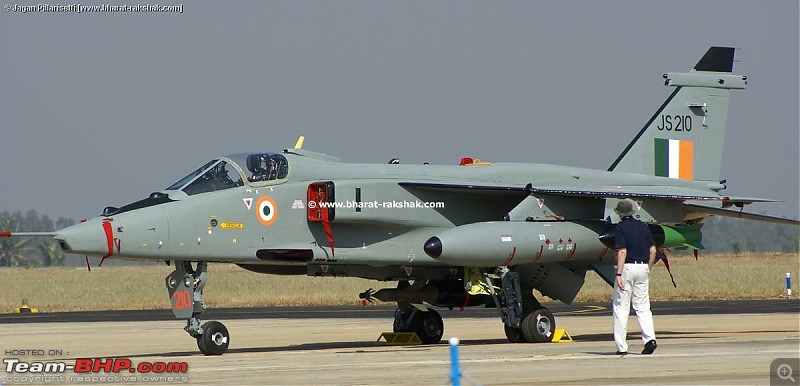 The Jaguars of the IAF were designed to a higher standard than the British or French versions with more powerful engines and the DARIN avionics suite. This suite was designed by India in collaboration with the British to give our Jaguars a superior navigation and weapons delivery capability. In later years we upgraded the DARIN configuration to higher versions II and now III using French & Israeli avionics and Indian systems integration. Last edited by V.Narayan : 7th August 2016 at 11:10. |
| |  (5)
Thanks (5)
Thanks
 |
| The following 5 BHPians Thank V.Narayan for this useful post: | BoltThrower, kosjam, Samba, SnS_12, SolitaryRabbit |
| | #8 |
| BHPian Join Date: Mar 2013 Location: KOL-DEL-LKO
Posts: 719
Thanked: 3,511 Times
| re: Scale Models - Aircraft, Battle Tanks & Ships Great thread Sir. It is not only the pictures of the scale model that makes this thread special. The write up on each of the models mentioning their history & specialty makes this one a five star thread. Waiting for more updates. Regards, Pawan |
| |  (1)
Thanks (1)
Thanks
 |
| The following BHPian Thanks PapaBravo for this useful post: | Samba |
| | #9 |
| Senior - BHPian | re: Scale Models - Aircraft, Battle Tanks & Ships Nice collection there, sir  . .Here are a few of mine. 1:60 Sikorsky SH-60B Seahawk    Modelled here is a SH-60B of US Navy Helicopter Maritime Strike Four Six (HSM-46), the "Grandmasters" The SH-60B is deployed primarily aboard frigates, destroyers, and cruisers. The primary missions of the SH-60B are surface warfare and anti-submarine warfare. It carries a complex system of sensors including a towed Magnetic Anomaly Detector (MAD) and air-launched sonobuoys. Other sensors include the APS-124 search radar, ALQ-142 ESM system and optional nose-mounted forward looking infrared (FLIR) turret. Munitions carried include the Mk 46, Mk 50, or Mk 54 torpedo, AGM-114 Hellfire missile, and a single cabin-door-mounted M60D/M240 7.62 mm (0.30 in) machine gun or GAU-16 .50 in (12.7 mm) machine gun. A standard crew for a SH-60B is one pilot, one ATO/Co-Pilot (Airborne Tactical Officer), and an enlisted aviation warfare systems operator (sensor operator). Operating squadrons are designated Helicopter Anti-Submarine Squadron, Light (HSL). A modernised variant, designated as the MH-60R, was in the running for Indian Navy's requiremnt of ASW helicopters to replace the Sea King Mk.42B "Flying Frigates". 1:55 AH-1Z Viper  Modelled here is a AH-1Z Viper of US Navy Air Test and Evaluation Squadron Nine (VX-9) "The Vampires". The model is actually closer to the W model than the Z model. 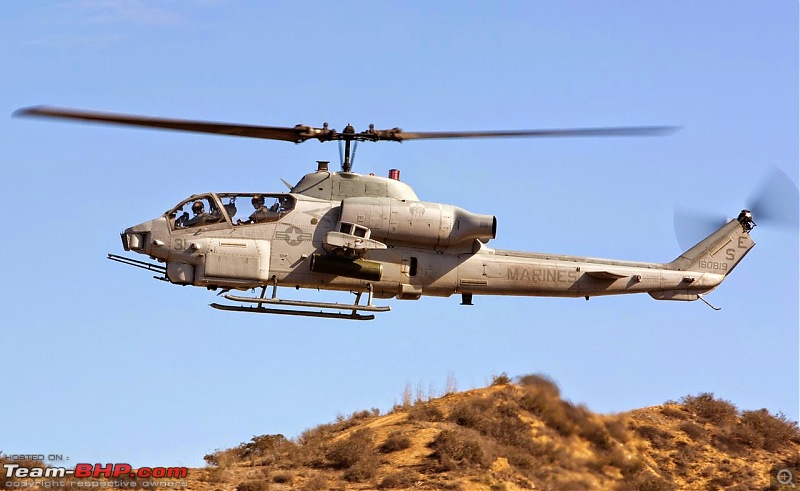 The Bell AH-1Z Viper is a twin-engine attack helicopter based on the AH-1W Super Cobra, that was developed for the United States Marine Corps (USMC). The Pakistan Army Aviation has 15 AH-1Zs on order( to replace/supplement early model AH-1s in service). Armament Guns: 1 ◊ 20 mm (0.787 in) M197 3-barreled Gatling cannon in the A/A49E-7 turret (750 round ammo capacity) Hardpoints: Up to 6 pylon stations on stub wing Rockets: 2.75 in (70 mm) Hydra 70 or APKWS II[36] rockets – Mounted in LAU-68C/A (7 shot) or LAU-61D/A (19 shot) launchers Missiles: AIM-9 Sidewinder air-to-air missiles – 1 mounted on each wing tip station (total of 2) AGM-114 Hellfire air-to-surface missiles – Up to 16 missiles mounted in four 4-round M272 missile launchers, two on each wing 1:55 Boeing AH-64A Apache 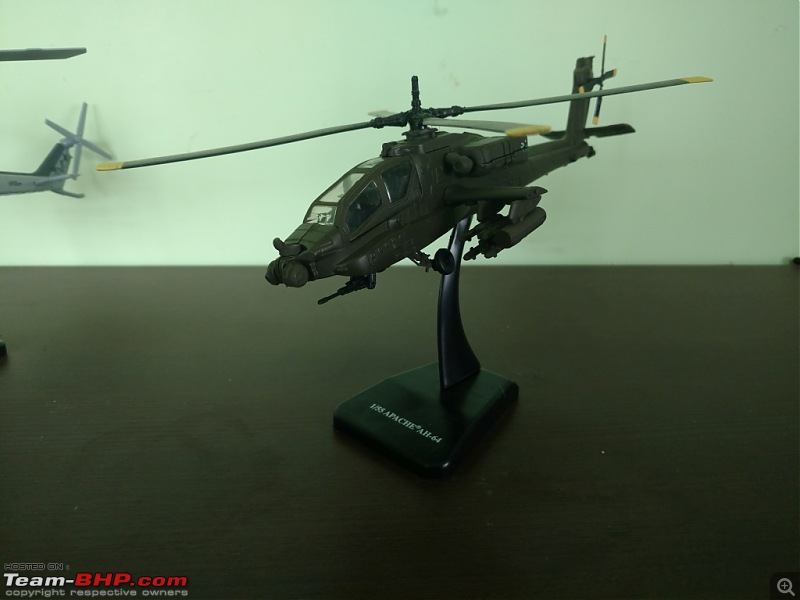 Modelled here is a generic AH-64A Apache of US Army Aviation. 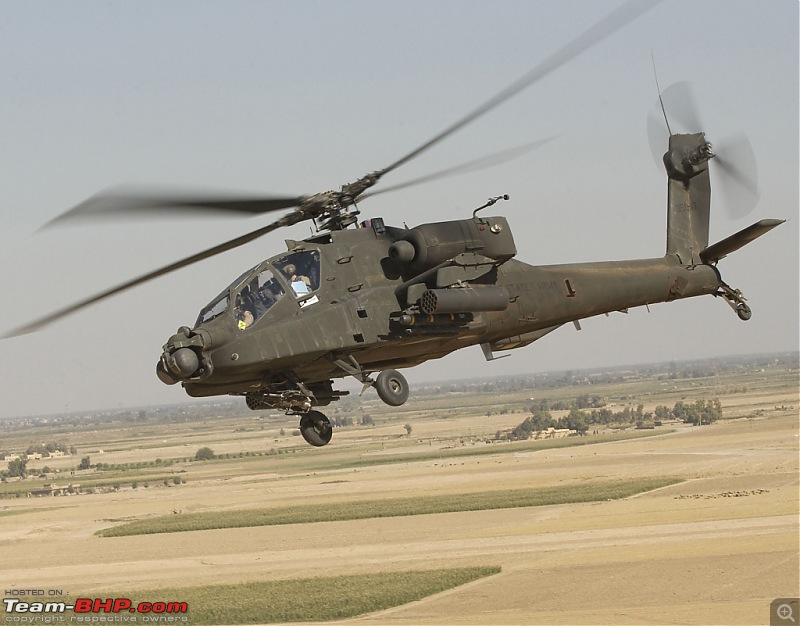 The Boeing AH-64 Apache is an American four-blade, twin-turboshaft attack helicopter with a tailwheel-type landing gear arrangement and a tandem cockpit for a two-man crew. It features a nose-mounted sensor suite for target acquisition and night vision systems. It is armed with a 30 mm (1.18 in) M230 chain gun carried between the main landing gear, under the aircraft's forward fuselage. It has four hardpoints mounted on stub-wing pylons, typically carrying a mixture of AGM-114 Hellfire missiles and Hydra 70 rocket pods. The Indian Air Force has its modernised and latest version on order - the AH-64E Blk III Apache Guardian. and lastly, my favorite, 1:200 Sukhoi Su-30K Flanker Indian AF SB008    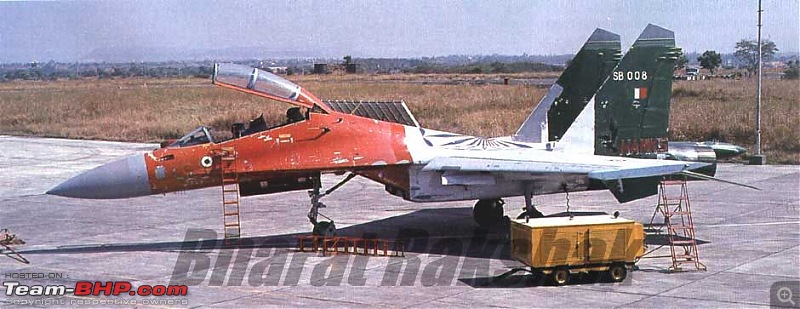 Modelled here is a Sukhoi Su-30K SB008 of IAF's No.24 Sqdn "Hawks". The model is extremely small and just about the size of my palm, but inspite of being such a small model, the level of detailing is insane, specially the clarity of the markings.This scheme was painted on Three SU-30Ks ( SB-001, 006 & 008 for Republic Day flypast in1998) These twin seat Su-30K/MKs (NATO Reporting name Flanker) were derived from the twin seat Su-27UB trainer. In Indian service, these were the predecessors of the current Su-30MKI variant and had limited BVR and PGM capability. 18 of these models were acquired initially (SB001 to SB018). These were sent back to Russia after No.24 Sqdn inducted Su-30MKIs after it was found that upgrading these airframes to MKI standard was not feasable. Direct Deliveries from Russia 1st-8th Ac , Su-30Ks (SB-001 to SB-008) inducted on 11 June 1997 (Now Withdrawn from Service) 9th-18th Ac , Su-30MKs (SB-009 to SB-018) inducted later (Now Withdrawn from Service) These Su-30K/MKs were to be upgraded to SU-30KN standards and were to be sold to Belarus, a deal which never materialized and the fate of these ex-Indian Flankers are unknown. Last edited by skanchan95 : 9th August 2016 at 11:25. |
| |  (2)
Thanks (2)
Thanks
 |
| The following 2 BHPians Thank skanchan95 for this useful post: | BoltThrower, kosjam |
| | #10 |
| Distinguished - BHPian  | re: Scale Models - Aircraft, Battle Tanks & Ships Very nice thread and a very nice collection of models. I happen to be spending a week and a half in London and I visited the Royal Airforce Museum here in London. http://www.rafmuseum.org.uk/london/ I thought I had just about seen all aviation/RAF museums in the UK. But this was my first visit to this particular one. Itís a bit of hidden gem. Well away from London city. About 35 minutes by tube, then a 15 minute walk. I just happen to take two pictures of the ME262 also featured in your story. Jeroen   |
| |  ()
Thanks ()
Thanks
 |
| | #11 | |
| Distinguished - BHPian  Join Date: Aug 2014 Location: Delhi-NCR
Posts: 4,071
Thanked: 64,305 Times
| re: Scale Models - Aircraft, Battle Tanks & Ships
Nempuguru, One more below... Sandesh, thank you for being the first to post your collection on this thread. Excellent choppers there in your hangar. Look forward to more of your collection. Quote:
The Bleriot XI  The Bleriot XI was designed and flown by Louis Bleriot, a French aviator and inventor, in July 1909 across the English Channel. With this he became the first to fly across a significant body of water and across two countries in a heavier than air machine. The scale model above is of the Bleriot XI (his 11th aircraft design) is a 1:20 replica.  Bleriot was already an accomplished aviator and designer by 1909 having won several prizes for closed circuit flying, had stayed aloft for 50 minutes and successfully flown a distance of 41 kms between towns in France. His cross channel flight lasted ~36 minutes. In his excitement he forgot to carry a compass and navigated by dead reckoning and the sun!!  The Bleriot XI roughly had a length and wing span of 25' . It was powered by a 25 hp 3-cylinder radial piston engine which drove a 6' 10" diameter two-blade propeller made from walnut wood. The aircraft weighed 230 kgs empty. 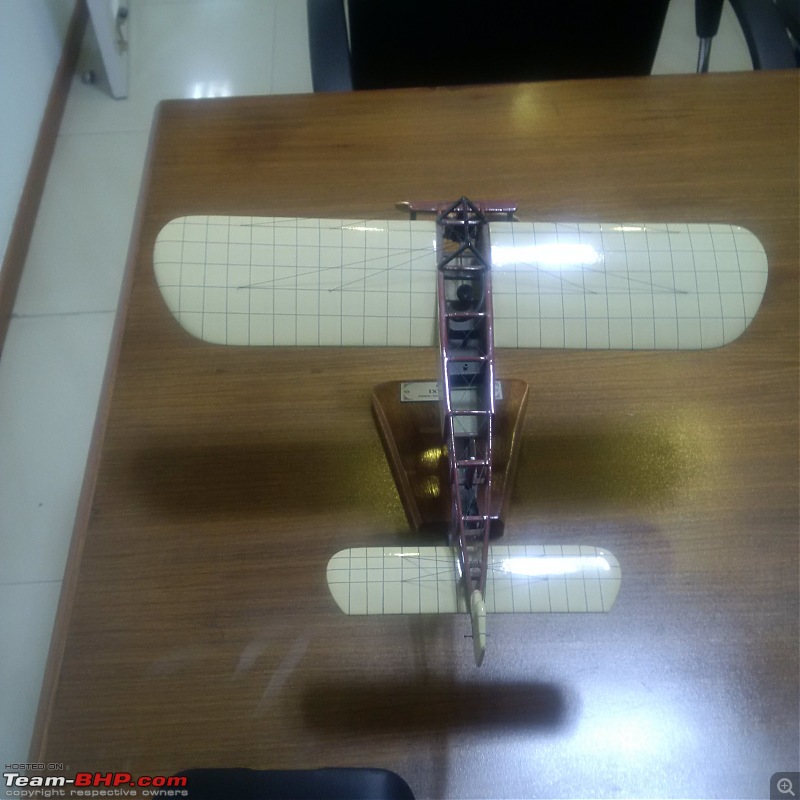 Most aeroplanes in the first two decades of the 20th century were biplanes ie with two wings one on top of the other. Bleriot was unusual in developing monoplanes ie a single wing which is the norm today. Early wings were, understandably, primitive in their aerofoil lift capability and hence needed two wings (it is also structurally simpler to manufacture). A monoplane had the advantage of lesser weight and drag - two essentials of aeronautical design which make or break designs even today. 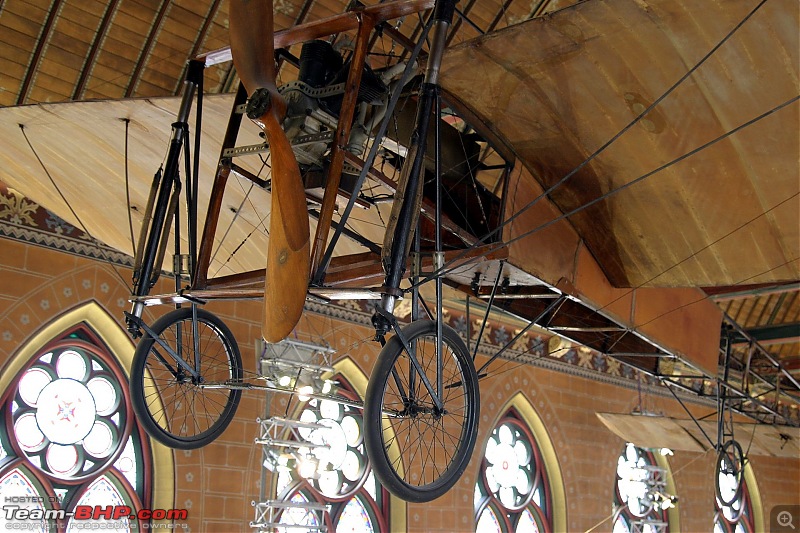 The original Bleriot XI preserved at a museum in France. While on its pioneering cross channel flight the Bleriot XI clocked an average speed of 72 kmph. It was followed by a fast French warship which itself was capable of 48 kmph and during parts of the flight when Louis Bleriot was facing headwinds the aircraft and warship were at times moving in tandem!! The French Navy chivalrously took Madame Bleriot on board to witness the flight.  Bleriot photographed while enroute on his epic flight. Later in life he also became a successful aircraft manufacturer selling fighters in World War I under the trade name SPAD. Last edited by V.Narayan : 11th August 2016 at 19:06. | |
| |  (1)
Thanks (1)
Thanks
 |
| The following BHPian Thanks V.Narayan for this useful post: | BoltThrower |
| |
| | #12 |
| BHPian Join Date: Aug 2015 Location: BLR-UD
Posts: 220
Thanked: 841 Times
| re: Scale Models - Aircraft, Battle Tanks & Ships Again, thank you for sharing detailed info with nice pictures. All your threads are "encyclopedia of stealth, warships, aircraft" for novices like us. Keep 'em coming.  |
| |  ()
Thanks ()
Thanks
 |
| | #13 |
| Distinguished - BHPian  | re: Scale Models - Aircraft, Battle Tanks & Ships I had no idea the original Bleriot survived, very nice. As luck would have it, this RAF London museum also had a replica of this very plane. I took a close up, as I was particularly intrigued by the elastic band suspension! Jeroen 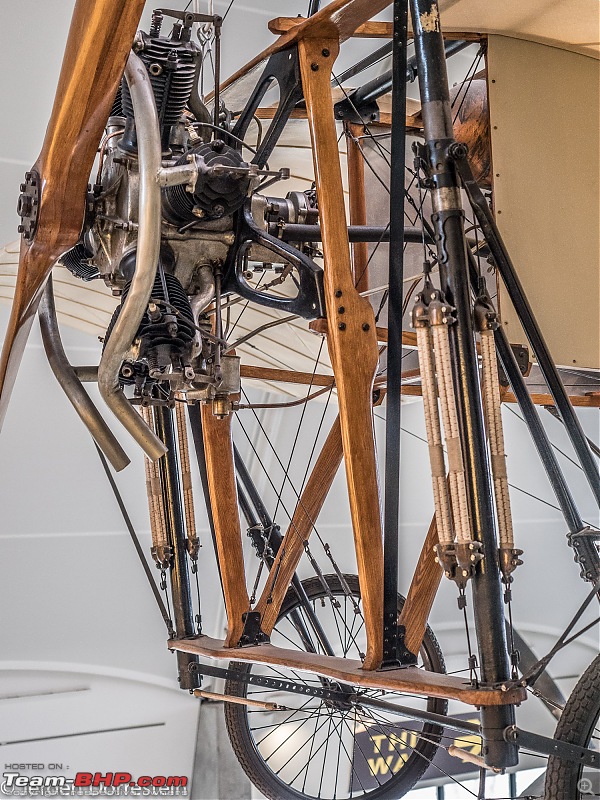 |
| |  ()
Thanks ()
Thanks
 |
| | #14 |
| BHPian Join Date: Jan 2014 Location: Kolkata - Pune
Posts: 726
Thanked: 2,799 Times
| re: Scale Models - Aircraft, Battle Tanks & Ships Got this cheapo scale model of Delta Lockheed 10 Electra long time back, manufactured by Newray and clicked some pics. Aircraft Make & Model: Lockheed 10-B Electra MTOW: 10,300 lb. Range: 350 miles Speed: 190 mph Seats: 10 passengers Length: 39 ft. Wingspan: 55 ft. Height: 10 ft. Engines: 2 Pratt & Whitney Wasp HP or Thrust: 450 hp No. flown by DL: 6 total: 1 Model 10-B purchased from Eastern Airlines, 4 Model 10-Bs purchased new from Lockheed, 1 Model 10-A leased from Braniff Airways (December 1939-March 20, 1940) RoutesFlown: Forth Worth, Texas, to Charleston, South Carolina (Air Mail Route 24) First Delivery: December 21, 1935 First Scheduled Service: January 10, 1936 Reason Aquired: Faster, larger, and more comfortable than the Stinson T and Stinson A. Most modern instrumentation of the day. Last Retirement: June 1942 Reason Disposed: Four requisitioned by the military for wartime use. https://www.deltamuseum.org/exhibits/delta-history/aircraft-by-type/propeller/lockheed-10-electra  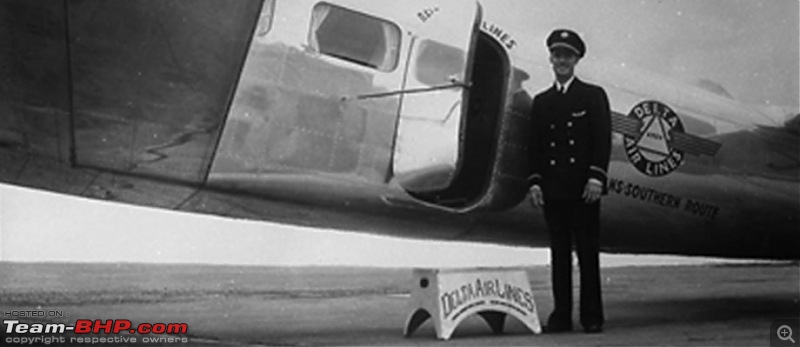 The Electra was Deltaís first all-metal aircraft and held 10 passengers and 2 pilots. Cabin appointments included hat nets, window curtains, a dome light, reading lamps, ashtrays, drinking water and a lavatory. With the Lockheed 10, Delta introduced its first onboard meal service box lunches and coffee served by the co-pilot. 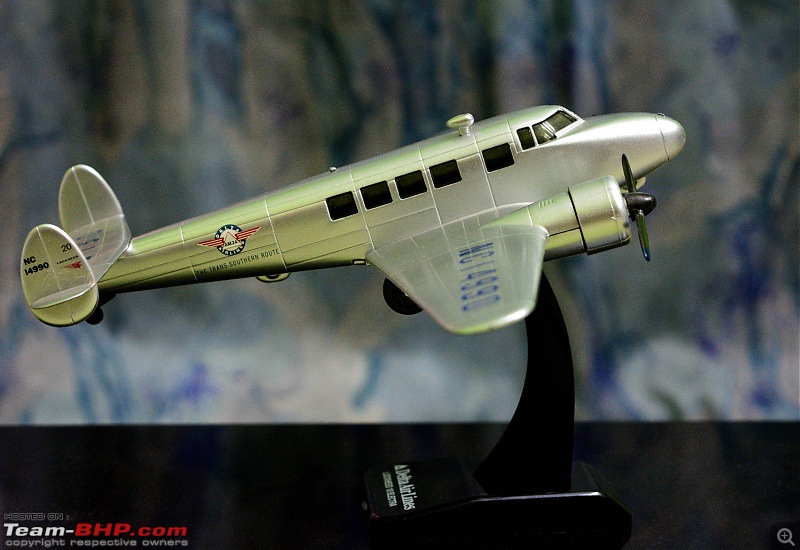   |
| |  (1)
Thanks (1)
Thanks
 |
| The following BHPian Thanks Samfromindia for this useful post: | Samba |
| | #15 | ||
| Distinguished - BHPian  Join Date: Aug 2014 Location: Delhi-NCR
Posts: 4,071
Thanked: 64,305 Times
| re: Scale Models - Aircraft, Battle Tanks & Ships Quote:
Quote:
 Amelia Earhart an American pioneering aviatrix (ie a female aviator) who set several world records and firsts in aviation in the 1920s and 1930s.  The Boeing 247 which along with the Lockheed Electra 10 opened the gates for profitable commercial airline service using land based planes (as opposed to seaplanes) | ||
| |  (1)
Thanks (1)
Thanks
 |
| The following BHPian Thanks V.Narayan for this useful post: | Samba |
 |


